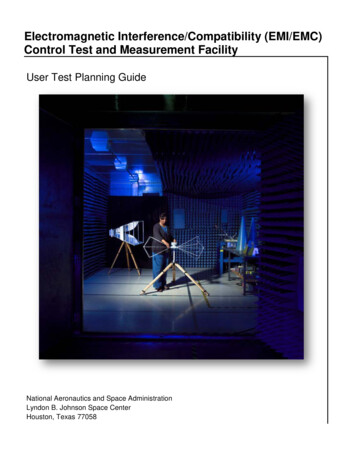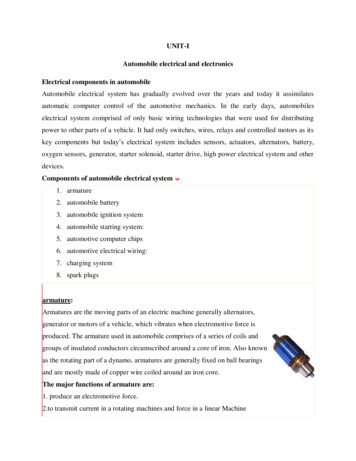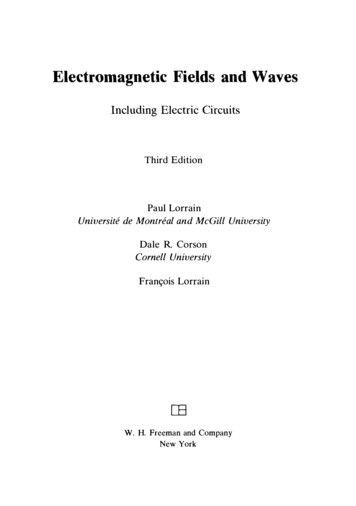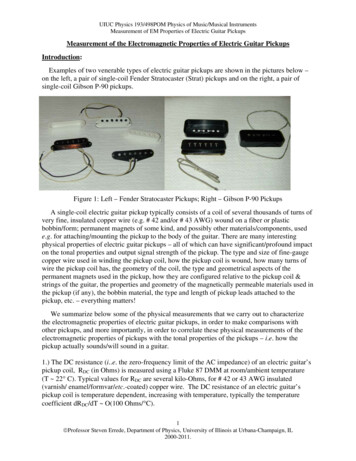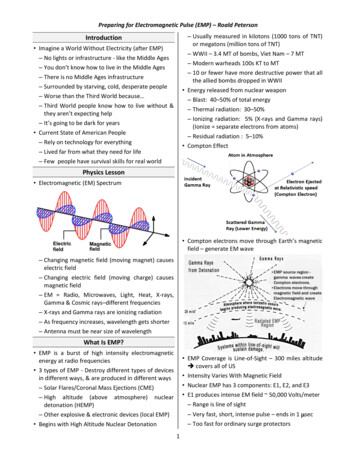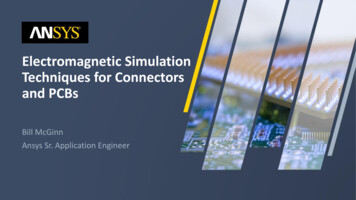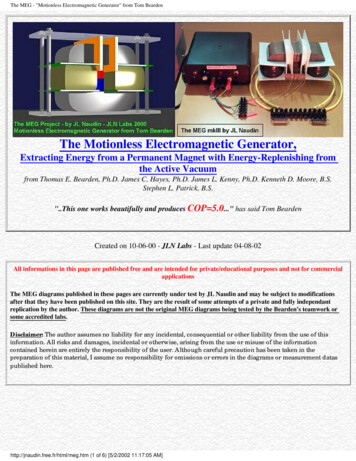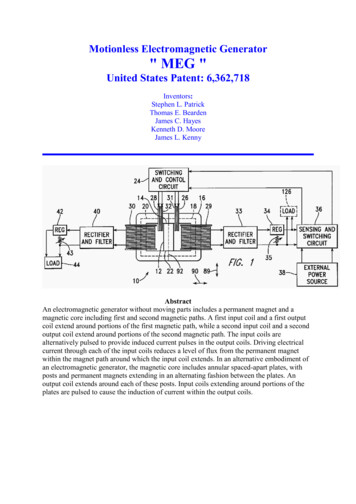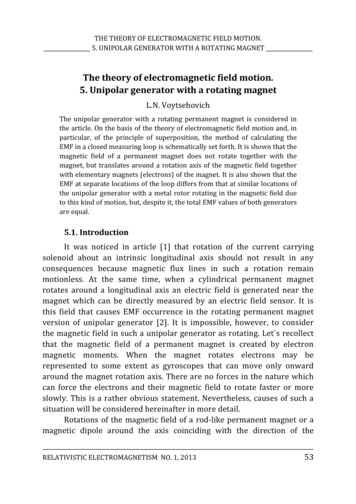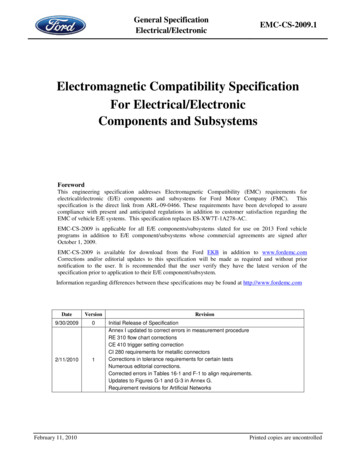
Transcription
General ctromagnetic Compatibility SpecificationFor Electrical/ElectronicComponents and SubsystemsForewordThis engineering specification addresses Electromagnetic Compatibility (EMC) requirements forelectrical/electronic (E/E) components and subsystems for Ford Motor Company (FMC). Thisspecification is the direct link from ARL-09-0466. These requirements have been developed to assurecompliance with present and anticipated regulations in addition to customer satisfaction regarding theEMC of vehicle E/E systems. This specification replaces ES-XW7T-1A278-AC.EMC-CS-2009 is applicable for all E/E components/subsystems slated for use on 2013 Ford vehicleprograms in addition to E/E component/subsystems whose commercial agreements are signed afterOctober 1, 2009.EMC-CS-2009 is available for download from the Ford EKB in addition to www.fordemc.comCorrections and/or editorial updates to this specification will be made as required and without priornotification to the user. It is recommended that the user verify they have the latest version of thespecification prior to application to their E/E component/subsystem.Information regarding differences between these specifications may be found at 101February 11, 2010RevisionInitial Release of SpecificationAnnex I updated to correct errors in measurement procedureRE 310 flow chart correctionsCE 410 trigger setting correctionCI 280 requirements for metallic connectorsCorrections in tolerance requirements for certain testsNumerous editorial corrections.Corrected errors in Tables 16-1 and F-1 to align requirements.Updates to Figures G-1 and G-3 in Annex G.Requirement revisions for Artificial NetworksPrinted copies are uncontrolled
EMC-CS-2009.1Table of Contents:Foreword.11.0Scope .62.0References.73.0Abbreviations, Acronyms, Definitions, & Symbols .84.0Common Test Requirements.115.0Additional Requirements .126.0Requirement Applicability.137.0Radiated RF Emissions: RE 310.158.0Conducted RF Emissions: CE 420.249.0Conducted Emissions: CE 421.2610.0 Conducted Transient Emissions: CE 410.2911.0 RF Immunity: RI 112, RI 114, RI 115.3112.0 Magnetic Field Immunity: RI 140 .4613.0 Coupled Immunity: RI 130 .5014.0 Coupled Immunity: RI 150 .5315.0 Immunity from Continuous Power Line Disturbances: CI 210 .5616.0 Immunity from Transient Disturbances: CI 220 .5917.0 Immunity from Power Cycling: CI 230 .6418.0 Immunity to Ground Voltage Offset: CI 250.6719.0 Immunity to Voltage Dropout: CI 260.7220.0 Immunity to Voltage Overstress: CI 270 .7921.0 Electrostatic Discharge: CI 280 .80Annex A (Normative): Field Calibration Procedure for ALSE Method Bands 6 and 7).86Annex B (Normative): Modulation and Leveling Requirements for RI 112, RI 114 and RI 115 .91Annex C (Normative): Mode Tuning Chamber Calibration .93Annex D (Normative): CI 220 Transient Waveform Descriptions.100Annex E (Normative): Transient Waveform Application.109Annex F(Normative): Transient Test Generator.111Annex G (Normative): Load Simulator Requirements.114Annex H (Normative): RI 130, RI 150 Test Fixture and Application .118Annex I(Normative): Method for Determining Correction Factor for CE 421.120List of FiguresFigure 7-1: RE 310 Test Antenna Cable Configuration (excludes Rod antenna) .18Figure 7-2: RE 310 Test Setup (EU1, G1) DUTs with Selected Wiring in Engine Compartment .18Figure 7-3: Recommended Process for Assessing DUT Emissions per RE 310 Level 1 Requirements .22Figure 7-4: Recommended Process for Assessing DUT Emissions to RE310 Level 2 Requirements .23Figure 9-1: CE 421 Conducted Emissions Requirements.26Figure 9-2: CE 421 Test Setup .27Figure 9-3: Typical Correction Factor for a CISPR 25 Artificial Network .27Figure 10-1: CE 410 Transient Emissions Test .30Figure 11-1: RI 112 Requirements using Bulk Current Injection (BCI).33 Copyright Ford Motor Company – All Rights ReservedFebruary 11, 2010Page 2 of 121
EMC-CS-2009.1Figure 11-2: RI 112 DUT Harness Configurations.35Figure 11-3: RI 114 ALSE Test Setup (1000 – 2000 MHz) excluding Bands 6 and 7.37Figure 11-4: RI 114 ALSE Test Setup for Bands 6 and 7 .39Figure 11-5: RI 115 Test Setup.42Figure 11-6: RI 115 Setup for Calibration .43Figure 11-7: RI 115 Antenna positioning for testing the harness .45Figure 12-1: RI 140 Magnetic Field Immunity Requirements.46Figure 12-2: RI 140 Magnetic Immunity Test Setup: Radiating Loop .48Figure 12-3: RI 140 Magnetic Immunity Test Setups for Helmholtz Coil .49Figure 13-1: RI 130 Default Test Setup.51Figure 14-1: RI 150 Coupled Immunity Requirements .53Figure 14-2: RI 150 Test Setup.54Figure 15-1: CI 210 Requirements .56Figure 15-2: CI 210 Test Setup.57Figure 15-3: CI 210 AC Stress Level (US) Superimposed on DUT Supply Voltage (UP) .58Figure 16-1: CI 220 Test Setup for Devices with a Single Power Supply Circuit .60Figure 16-2: CI 220 Test Setup for Devices with Two Power Supply Connections.61Figure 16-3: CI 220 Test Setup for Devices with Input Circuits .61Figure 16-4: CI 220 Test Setup Detail (Input Circuits with Remote External Pull-Up Resistor) .62Figure 16-5: CI 220 Test Setup for Application of Pulse G1.62Figure 16-6: CI 220 Test setup for Application of Pulse G2 .62Figure 17-1: CI 230 Power Cycling Waveforms and Timing Sequence.65Figure 17-2: CI 230 Power Cycling Test Setup .66Figure 18-1: CI 250 Requirements (Continuous Disturbances).67Figure 18-2: CI 250 Transient Pulse Detail .68Figure 18-3: CI 250 Transient Pulse Delay Detail.68Figure 18-4: CI 250 Requirements (Transient Disturbance Sequence) .68Figure 18-5: CI 250 Test Setup for Ground Offset of DUT .70Figure 18-6: CI 250 Signal Source Requirements .70Figure 19-1: CI 260 Waveform A (Voltage Dropout: High) .73Figure 19-2: CI 260 Waveform B (Voltage Dropout: Low) .73Figure 19-3: CI 260 Waveform C (Single Voltage Dropout) .74Figure 19-4: CI 260 Waveform D (Voltage Dip) .74Figure 19-5: CI 260 Waveform E (Battery Recovery).75Figure 19-6: CI 260 Waveform F (Random Bounce) .75Figure 19-7: CI 260 Waveform F (Expanded).
electrical/electronic (E/E) components and subsystems for Ford Motor Company (FMC). This specification is the direct link from ARL-09-0466. These requirements have been developed to assure compliance with present and anticipated regulations in addition to customer satisfaction regarding the EMC of vehicle E/E systems. This specification replaces ES-XW7T-1A278-AC. EMC-CS-2009 is
